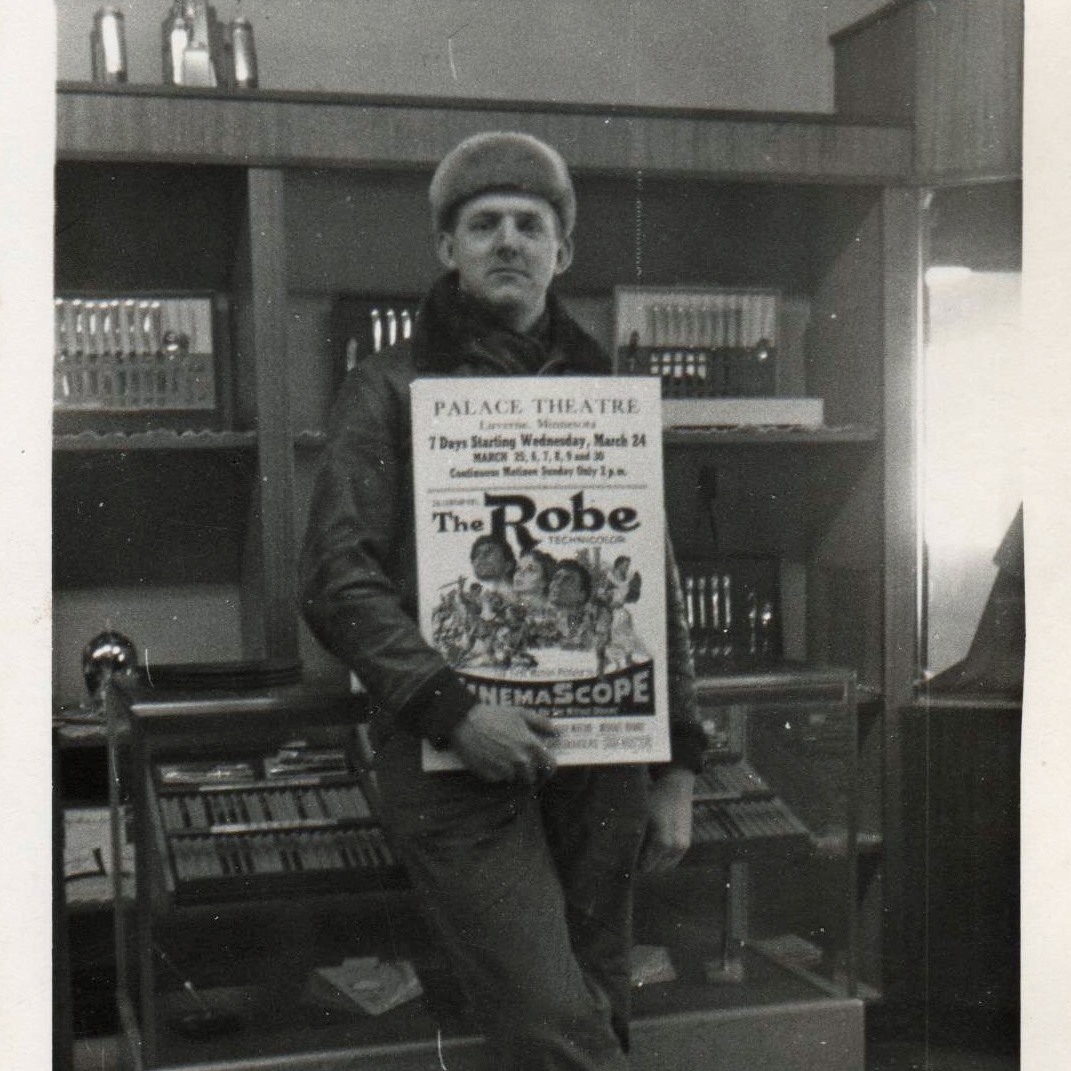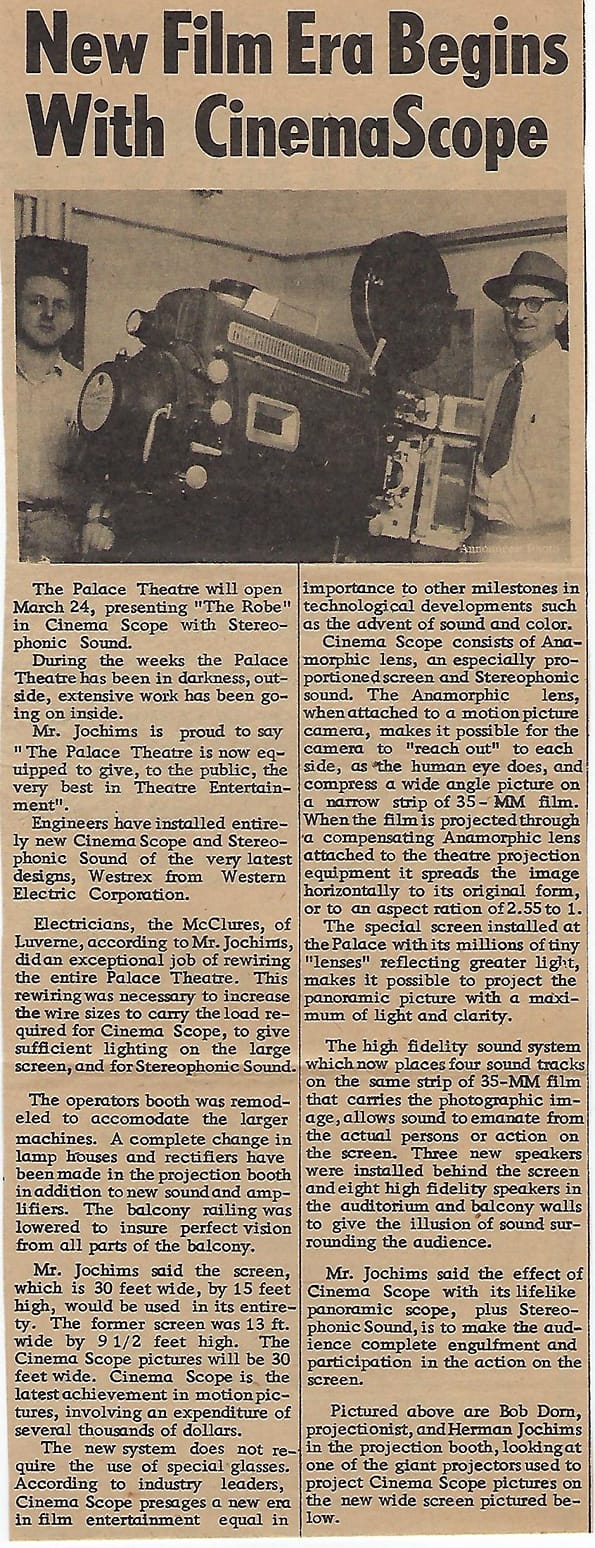



CinemaScope Comes to Luverne (1954)
Movie History is Palace History
Bob Dorn had a passion for the Palace Theatre. He kept a watchful eye on what was going on inside its doors and he spent countless hours on repairs and maintenance. There were days he stopped by several times just to make sure everything was operating properly. Bob is pictured in front of the concession stand in 1954. He’s holding a movie poster for “The Robe”, the first film ever filmed in CinemaScope.
What do you do when you have three geriatric sisters as patients and all they want to do is sit at home and talk to one another—all at the same time? You move another person in with them. At least, that’s what Doc Lomax does when he has a new nurse needing a place to live—a nurse with a secret, that is. The hard part is convincing the sisters they need a roomer. In no time, however, Nurse Jean has them planning parties, pulling Halloween pranks and wearing jogging suits while they race each other to the corner. But when the nephew shows up with a plan to sell the family house, things seem to get complicated again, especially with Christmas just around the corner. This heartwarming piece is loaded with wisecracks and one-liners that keep the laughter flowing.
The following is an article from the Star Herald in 1954 when CinemaScope was installed at the Palace Theatre:
The Palace Theatre will open March 24, presenting The Robe in CinemaScope with Sterophonic Sound.
During the weeks the Palace Theatre has been in darkness, outside, extensive work has been going on inside.
Mr. Jochims is proud to say “The Palace Theatre is now equipped to give the public the very best in Theatre Entertainment.”
Engineers have installed entirely new CinemaScope and Sterophonic Sound of the very latest designs, Westrex from Western Electric Corporation.
Electricians, the McClures of Luverne, according to Mr. Jochims, did an exceptional job or rewiring the entire Palace Theatre. This rewiring was necessary to increase the wire sizes to carry the load required for CinemaScope, to give sufficient lighting on the large screen, and for Stereophonic Sound.
The operators booth was remodeled to accommodate the larger machines. A complete change in lamp houses and rectifiers have been made in the projection booth in addition to new sound amplifiers. The balcony railing was lowered to insure perfect vision from all parts of the balcony.
Mr. Jochims said the screen, which is 30 feet wide by 15 feet high, would be used in its entirety. The former screen was 13 ft wide by 9 1/2 ft high. The CinemaScope pictures will be 30 feet wide. CinemaScope is the latest achievement in motion pictures, involving an expenditure of several thousand dollars.
The new system does not require the use of special glasses. According to industry leaders, CinemaScope presages a new era in film entertainment equal in importance to other milestones in technological development such as the advent of sound and color.
CinemaScope consists of Anamorphic lens, and especially proportioned screen and Sterophonic Sound. The Anamorphic lens, when attached to a motion picture camera, makes it possible for the camera to “reach out” to each side, as the human eye does, and compress wide angle picture on a narrow strip of 35-MM film. When the film is projected through a compensating Anamorphic lens attached to the theatre’s projection equipment it spreads the image horizontally to its original form, or to an aspect ratio of 2.55 to 1.
The special screen installed at the Palace with its millions of tiny “lenses: reflecting greater light, makes it possible to project the panoramic picture with maximum light and clarity.
The high fidelity sound system which now places four sound tracks on the same strip of 35-MM film that carries the photographic image, allows sound to emanate from the actual persons or action on the screen. Three new speakers were installed behind the screen and eight high fidelity speakers in the auditorium and balcony wall to give the illusion of sound surrounding the audience.
Mr. Jochims said the effect of CinemaScope with its lifelike panoramic scope, plus Stereophonic sound, is to make the audience complete engulfment and participation in the action on the screen.
Pictured above are Bob Dorn, projectionist, and Herman Jochims in the projection booth, looking at on of the giant projectors used to project CinemaScope pictures on the new wide screen pictured below.
